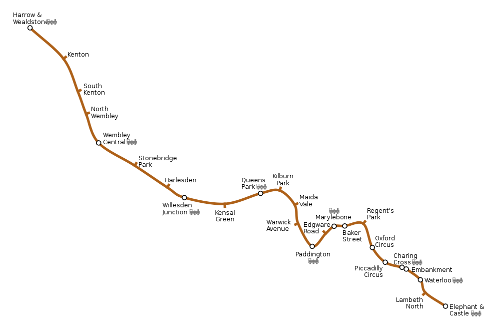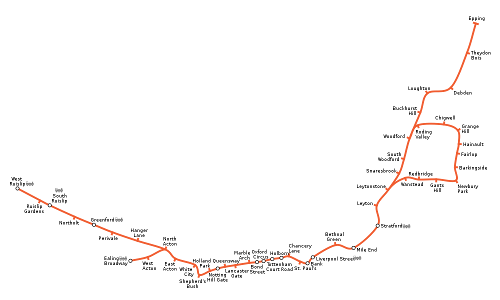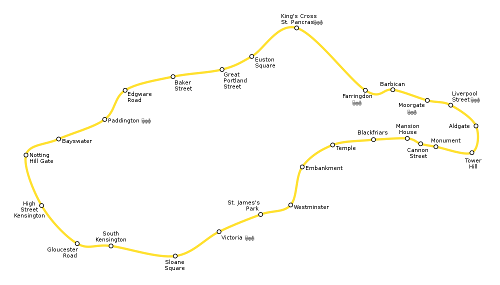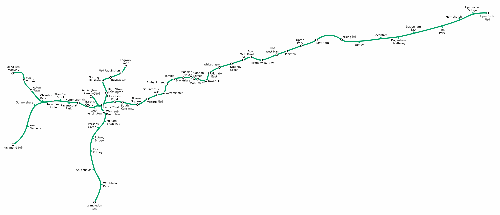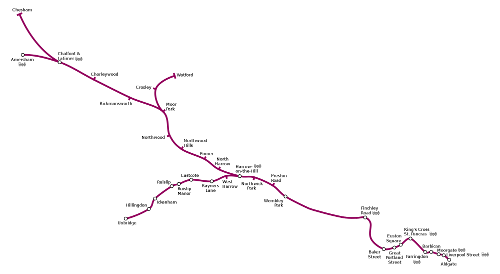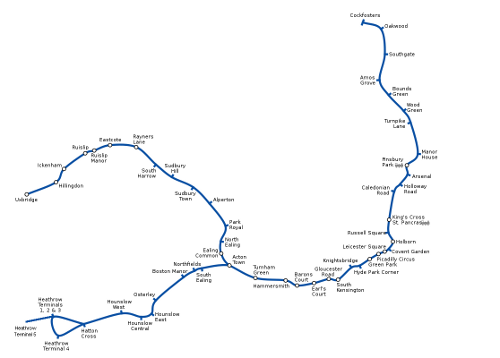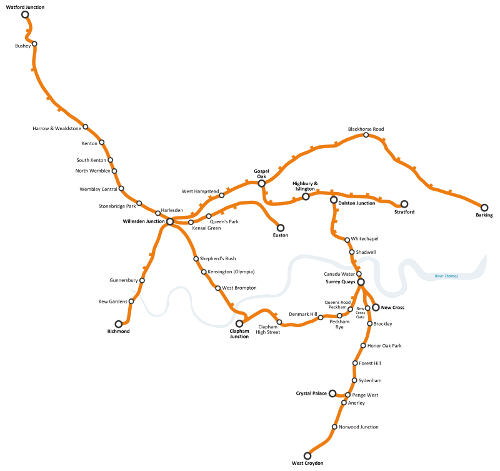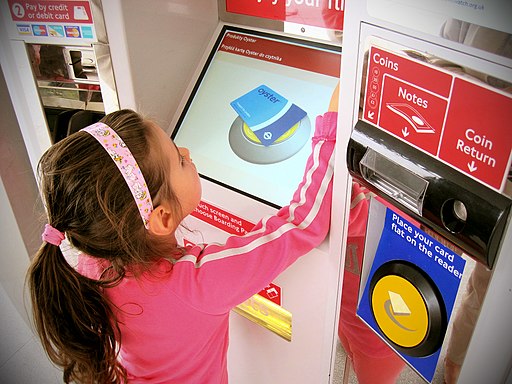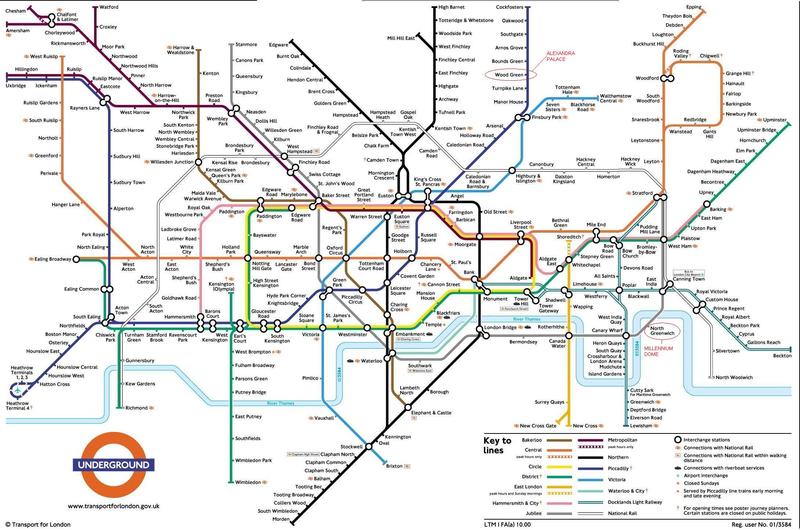London Underground, also known as the tube is the best way to get around and explore the city. The metro covers most areas of the city. And although cheap compared with other options such as taxi, as transportation is not the cheapest. Below we tell you how to save some money if your planning to use it often
London Underground, The Tube
The London Underground covers almost all areas of the city and by being one of the largest systems you will always find a station near your location or destination. According to Wikipedia, it is the largest underground network in Europe and the fourth in the world, after the huge asian metro systems in Seoul, Shanghai and Beijing. The London Underground is the oldest one in the world. It was inaugurated on January 18, 1863.
In addition to the Greater London, the London Underground also serves parts of the counties of Essex, Hertfordshire and Bucking-hamshire. The tube tariff zone is made up of nine concentric zones from the historic downtown area. Zones 1 and 2 are the center of the city, home to most tourist attractions. From the area 6 is the periphery of the city. Heathrow Airport is in zone 6. Metro, Overground and national rail operate in the 9 zones. Other public transport services only serve zones 1-6.
London Underground has 13 lines (including the Doklands Light Railway, DLR) and 275 stations.
Some of these lines are on the surface, such as the Metropolitan, District, Circle, Hammersmith & City ... some other lines in the center have a few stretches that are on the surface. Other lines are underground all the way, as Bakerloo, Central, Jubilee, Northern Piccadilly, Victoria, Waterloo and City lines.
Zones are also classified as Eastbound, Westbound, Northbound or Southbound. This makes it quite easy to navigate within the underground.
Even though you can get a free copy of the London Underground Map and buses network at any information office or at any desk in almost every station, we facilitate it for you here at mapa-metro.com in case you want to study it in advance, or you need to ask any question or you want to familiarize yourself with the routes you are going to do during your stay in London.
How to ride the London Underground [VIDEO]
The basics
Full Info Video
Lines of London Underground
Bakerloo Line
It's the brown line. Some sections are in surface and others are underground. The line crosses London from north to south serving 25 stations and covering a distance of 23.2 kilometers. This line opened in 1906. Every year more than 100 million passengers ride this line.
Stations: Harrow & Wealdston, Kenton, South Kenton, North Wembley, Wembley Central, Stonebridge Park, Harlesden, Willesden Junction, Kensal Green, Queen's Park, Kilburn Park, Maida Vale, Warwick Avenue, Paddington, Edgware Road, Marylebone, Baker Street, Regent's Park, Oxford Circus, Piccadilly Circus, Charing Cross, Embankment, Waterloo, Lambeth North, Elphant & Castle.
Central Line:
It's the red line of the London Underground. The line circulates in the city center and the northern half. It serves a total of 49 stations in a distance of 74 kilometers. It's the longest line of the system. It's opened since 1900 and every year, more than 260 million people use this line
Stations: West Ruislip, Ruislip Gardens, South Ruislip, Northolt, Greenford, Perivale, Hanger Lane, Ealing Broadway, West Acton, North Acton, East Acton, White City, Shepherd's Bush, Holland Park, Notting Hill Gate, Queensway, Lancaster Gate, Marble Archa, Bond Street, Oxford Circus, Tottenham Court Road, Holborn, Chancery Lane, St Paul's, Bank, Liverpool Street, Bethnal Green, Mile End, Stratford, Leyton, Leytonstone, Wanstead, Redbridge, Gants Hill, Newbury Park, Barkingside, Fairlop, Hainault, Grange Hill, Chigwell, Roding Valley, Snaresbrook, South Woodford, Woodford, Buckhurst Hill, Loughton, Debden, Theydon Boys, Epping.
Circle Line
It's the circular line, yellow color in the undergroun map. It runs from Hammersmith to Edgware Road serving 36 stations in a 27 kilometers distance.
Stations : King's Cross St Pancras, Farringdon, Barbican, Moorgate, Liverpool Street, Aldgate, Tower Hill, Monument, Cannon Street, Mansion House, Blackfriars, Temple, Embankment, Westminster, St James' Park, Victoria, Sloane Square, South Kensington, Gloucester Road, High Street Kensington, Notting Hill Gate, Bayswater, Paddington, Edgware Road, Baker Street, Great Portland Street, Euston Square.
District Line
District line is the green line. It Crosses the Greater London from west to east covering a distance of 64 kilometers and serving 60 stations. Annually this line is used by more than 200 million passengers
Stations: Richmond, Kew Gardens, Gunnersbury, Ealing Broadway, Ealing Common, Acton Town, Chiswick Park, Turnham Green, Stamford Brook, Ravenscourt Park, Hammersmith, Barons Court, West Kensington , Kensington Olympia, Earls Court, Edgware Road, Paddington, Bayswater, Notting Hill Gate, High Street Kensington, Wimbledon, Wimbledon Park, Southfields, East Putney, Putney Bridge, Parsons Green, Fulham Broadway, West Brompton, Gloucester Road, South Kensington, Sloane Square, Victoria, St James' Park, Westminster, Embankment, Temple, Blackfriars, Mansion House, Cannon Street, Monument, Tower Hill, Aldgate East, Whitechapel, Stepney Green, Mile End, Bow Road, Bromley-by-Bow, West Ham, Plaistow, Upton Park, East Ham, Barking, Upney, Becontree, Dagenham Heathway, Elm Park, Hornchurch, Upminster Bridge, Upminster.
Hammersmith & City Line
It's the pink line of the London Underground. This line goes from Hammersmith to Barking, crossing the city from west to east and serving 29 stations on 25.5 kilometers.
Stations : Hammersmith, Goldhawk Road, Shepherd's Bush Market, Latimer Road, Ladbroke Grove, Westbourne Park, Royal Oak, Paddington, Edgware Road, Baker Street, Great Portland Street, Euston Square - King's Cross St Pancras, Farringdon, Barbican, Moorgate, Liverpool Street, Aldgate East, Whitechapel, Stepney Green, Mile End, Bow Road, Bromley-by-Bow, West Ham, Plaistow, Upton Park, East Ham, Barking.
Jubilee Line
It is the gray line of the Tube. It covers a distance of 36 kilometers and serves 27 stations. It is the most modern line of the system.
Stations : Stanmore, Canons Park, Queensbury, Kingsbury, Wembley Park, Neasden, Dollis Hill, Willesden Green, Kilburn, West Hampstead, Finchley Road, Swiss Cottage, St John's Wood Baker Street, Bond Street, Greenpark, Westminster, Waterloo, Southwark, London Bridge, Bermondsay, Canada Water, Canary Wharf, North Greenwich, Canning Town, Westham, Stratford.
Metropolitan Line
It is the purple line. It serves 34 stations in almost 67 kilometers.
Stations : Aldgate East, Liverpool Street, Moorgate, Barbican, Farringdon, King's Cross St Pancras, Euston Square, Great Portland Street, Baker Street, Finchley Road, Wembley Park, Preston Road , Northwick Park, Harrow-on-the-Hill, West Harrow, Rayners Lane, Eastcote, Ruislip Manor, Ruislip, Ickenham, Hillingdon, Uxbridge, North Harrow, Pinner, Northwood Hills, Northwood, Moor Park, Croxley, Watford, Rickmansworth, Chorleywood, Chalfont & Latimer, Amersham, Chesham.
Northern Line
It's the black line of the London Underground. Runs from north to south providing service to 50 stations on 58 kilometers. This line opened in 1890 and annually is used by 250 million people
Stations: High Barnet, Totteridge & Whetstone, Woodside Park, West Finchley, Mill Hill East, Finchley Central, East Finchley, Highgate, Archway, Tufnell Park, Kentish Town, Edgware , Burnt Oak, Colindale, Hendon Central, Brent Cross, Golders Green, Hampstead, Belsize Park, Chalk Farm, Camden Town, Mornington Crescent, Euston, King's Cross St Pancras, Angel, Old Street, Moorgate, Bank, London Bridge, Borough, Elephant & Castle, Kennington, Waterloo, Embankment, Charing Cross, Leicester Square, Tottenham Court Road, Goodge Street, Warren Street, Oval, Stockwell, Clapham North, Clapham Common, Clapham South, Balham, Tooting Bec, Tooting Broadway, Colliers Wood , South Wimbledon, Morden.
Piccadilly Line
It is the dark blue line. The line runes through the center, the north and reaches Heathrow Airport. It serves 53 stations in a 71 kilometers distance. Piccadilly line began service in 1906
Stations: Cockfosters, Oakwood, Southgate, Arnos Grove, Bounds Green, Wood Green, Turnpike Lane, Manor House, Finsbury Park, Arsenal, Holloway Road, Caledonian Road, King's Cross St Pancras, Russell Square, Holborn, Covent Garden, Leicester Square, Piccadilly Circus, Green Park, Hyde Park Corner, Knightsbridge, South Kensington, Gloucester Road, Earl's Court, Barons Court, Hammersmith, Turnham Green, Acton Town, Ealing Common, North Ealing , Park Royal, Alperton, Sudbury Town, Sudbury Hill, South Harrow, Rayners Lane, Eastcote, Ruislip Manor, Ruislip, Ickenham, Hillingdon, Uxbridge, South Ealing, Northfields, Boston Manor, Osterley, Hounslow East, Hounslow Central, Hounslow West, Hatton Cross, Heathrow Terminals 1, 2, 3, Heathrow Terminal 5, Heathrow Terminal 4.
Line Victoria
Is the blue line on the map. It covers a distance of 21 kilometers which serves 16 stations. It goes from London south to northeast.
Stations: Walthamstow Central, Blackhorse Road, Tottenham Hale, Seven Sisters, Finsbury Park, Highbury & Islington, King's Cross St Pancras, Euston, Warren Street, Oxford Circus, Green Park , Victoria, Pimlico, Vauxhall, Stockwell, Brixton.
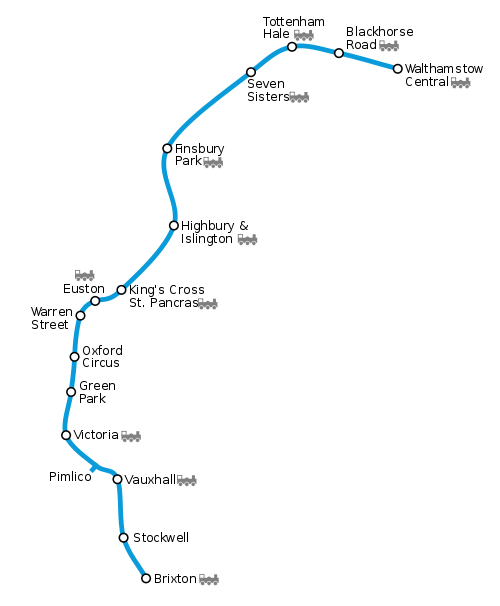
Waterloo & City
It's the turquoise subway line. Links Bank to Waterloo circulating under the Thames river covering a distance of just 2,37 kilometers.
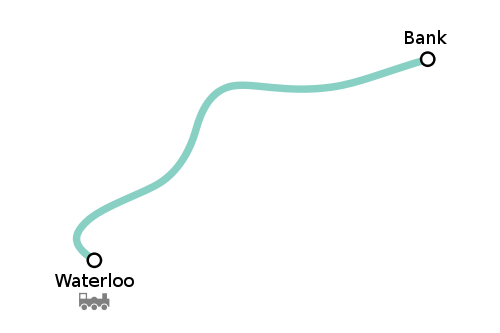
Line Overground
More than a line is an urban train network operating since 2007, serving much of the Greater London with its 112 stations. Overground lines are orange colour on the map.
Stations: Watford Junction, Watford High Street, Bushey, Carpenders Park, Hatch End, Headstone Lane, Harrow & Wealdstone, Kenton, South Kenton, North Wembley, Wembley Central, Stonebridge Park, Harlesden, Willesden Junction, Acton Central, South Acton, Gunnersbury, Kew Gardens, Richmond, Shepherd's Bush, Kensington (Olympia), West Brompton, Imperial Wharf, Clapham Junction, Kensal Green, Queen's Park, Killburn High Road, South Hampstead, Euston, Kensal Rise, Brondesbury Park, Brondesbury, West Hampstead, Finchley Road & Frognal, Hampstead Heath, Gospel Oak, Kentish Town West, Camden Road, Caledonian Road & Barnsbury, Highbury & Islington, Canonbury, Dalston Kingsland, Hackney Central , Homerton, Hackney Wick, Stratford, Haggerston, Hoxton, Shoreditch High Street, Whitechapel, Shadwell, Wapping, Rotherhithe, Canada Water, Surrey Quays, New Cross, New Cross Gate, Brockley, Honor Oak Park, Forest Hill, Sydenham, Crystal Palace , Penge West, Anerley, Norwood Junction, West Croydon, Upper Holloway, Crouch Hill, Harringay Green Lanes, South Tottenham, Blackhorse Road, Walthamstow Queen's Road, Layton Midland Road, Laytonstone High Road, Wanstead Park, Woodgrange Park, Barking.
Docklands Light Railway, DLR
Covers the eastern area. It's an light rail operating since 1987 in Docklands, Stratford, Lewisham, Tower Gateway and the business district, Beckton, London City Airport and Woolwich Arsenal. This system consists of 7 lines and 45 stations.
Stations: Bank, Tower Gateway, Shadwell, Limehouse, Westferry, Poplar, West India Quay, Canary Wharf, Heron Quays, South Quay, Crossharbour, Mudchute, Island Gardens, Cutty Sark for Maritime Greenwich, Greenwich, Deptford Bridge, Elverson Road, Lewisham, All Saints, Langdon Park, Devons Road, Bow Church, Pudding Mill Lane, Stratford, Blackwall, East India, Canning Town, Royal Victoria, Custom House for ExCeL Prince Regent , Royal Albert, Beckton Park, Cyprus, Gallions Reach, Beckton, West Silvertown, Pontoon Dock, London City Airport, King George V Woolwich Arsenal.
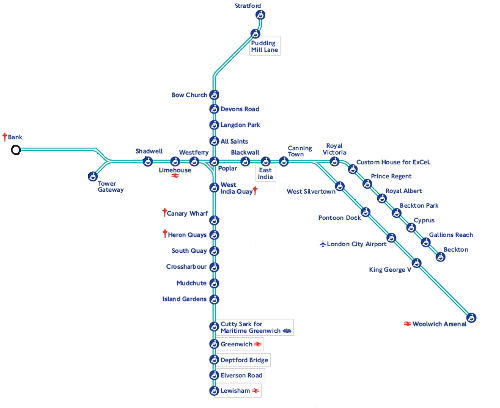
London underground: Hours, Schedule and frequency:
Usually from 5:30 a.m. to 12:00 Monday to Saturday. On Sundays timetable is reduced from 7.30 to 23.30. Frequency, depeding on the line, 2-5 minutes or 5-10 minutes.
London Underground schedule also differs between rush and normal hours. The first is from Monday to Friday from 6:30 am to 9:30 am and 4 pm to 7 pm except on holidays.
Underground not working hours are covered by night bus.
Rates and tickets
London Underground single tickets are expensive. If you're going to ride the tube often it is advisable to buy a Travelcard or an Oyster card. In central London (Zone 1 and 2) for example, one trip paid with an single ticket costs more than double that paid with an Oyster. It seems that from the London Underground are encouraging the use of cards because even prices for single tickets are hard to find in the official site.
| 2015 Fares | ||||
|---|---|---|---|---|
Zones |
Single ticket |
Oyster or contactless card |
||
| Adult | Children | Rush hours | Normal hours | |
| Zone 1 | £4.80 | £2.40 | £2.30 | £2.30 |
| Zone 1 and 2 | £4.80 | £2.40 | £2.90 | £2.30 |
| Zone 1 to 3 | £4.80 | £2.40 | £3.30 | £2.80 |
| Zone 1 to 4 | £5.80 | £2.90 | £3.90 | £2.80 |
| Zone 1 to 5 | £5.80 | £2.90 | £4.70 | £3.10 |
| Zone 1 to 6 | £6.00 | £3.00 | £5.10 | £3.10 |
| Zone 2 to 6 | £5.80 | £2.90 | £2.80 | £1.50 |
Child is about 5-15 years
Children under 11 years also travel for free on all buses.
Looking at the prices is clear that the authorities penalizes the use of single tickets to encourage the use of Oysters, contactless cards and Travelcards. Using cards on the London Underground has the additional advantage in addition to the discount price, not queuing to buy tickets. In addition to that with Oyster and Travelcards, you can use either various modes of transport: buses, subways, trains and DLR.
Children, students, elderly and disabled persons benefit from discounts and free trips.
Card Types:
Using cards on the London Underground is the best option to ride as it saves a considerable percentage of the price compared with the single tickets. There are two types of cards in addition to contactless cards:
- Travelcard (paper tickets)
- Oyster card (Smart card).
- Contactless Payment Cards.
Oyster Card
The Oyster cars are electronic cards that can be used in the Tube, DLR, trams, buses, Thames Clippers (River Boat), in the Emirates Airline cable car and nearly all National Rail services (national rail network). By using the Oyster you get significant discounts on each trip you make, and it is very interesting because as we said before the London Underground is not exactly cheap.
Using them is as easy as swiping the card through the reader is in each entry or exit barrier (they are yellow).
It's very important to re-validate the card at the exist so that the system can calculate the trip price. Otherwise, the maximum trip price would be applied. A trip on the underground may involve several train changes. The start point would be where you validate your ticket/card at the entrance of a station until you re-validate at the exit.
Oyster cards are prepaid cards and never expire. Although you use them without any control, the London Underground system estimates the number of trips you have made on 24-hour periods starting at 4.30 in the morning until the next day and applies the cheapest rate so you never pay more than using a 1-day Travelcard. This is called "daily capping". In fact you can charge Travelcards in your Oyster because Oyster are cash cards.
Oyster cards are bought and recharged at any subway station leaving a deposit of 5 pounds taht will be returned when delivering back the card.
Travelcard
They are paper cards or passes with a fixed price that allows you to make unlimited travels during its validity period. There are daily, monthly, weekly and annual cards. The price varies depending on the number of zones. Besides the Tube you can use them on buses, DLR, trams, and only in some Overground trains. Can be loaded in normal Oyster cards, but not in the Visitor Oyster
Besides travelcards with rates for adults or children, we can choose between:
- Anytime Day Travelcard, you can use them at any time of the day until 4:30 a.m. the next day
- Off Peak Day Travelcard, they are travelcards for normal business hours, and are valid from 9:30 am Monday to Friday and all day on Saturdays, Sundays and holidays. The period of validity of the daily travelcards is until 4.30 am the next day.
- 7 Day Travelcard, They are weekly travelcards. They can be used at any time during a week.
Contactless cards
The contactless cards are not exclusively for the London Underground. They are normal credit or debit cards that support contactless payment technology. The total cost of all trips you make in one day is calculated at the end of the day and a single charge is made to your card account. This card is used in the same way as Oyster, ie, passing it over the yellow readers on the barriers to entry to the subway. Paying at the London Underground with contactless cards have the same advantage of "daily capping" or limit than the Oyster payment. There is also a "weekly capping" or weekly limit, but works a little different than in Oyster. To benefit from the weekly spending limit in Oysters, the 7-day period can start any day of the week. In contactless cards the first day is always Monday.
Visitor Oyster Card
The Visitor Oyster Card is a special type of Oyster Card aimed for tourists. They sell it as the cheapest way to get around London if you come to visit. It is valid on the bus, metro, tram, DLR, Overground and rail services in London. You also get discounts on river services and the cable car. They can be recharged at any tube station, Oyster Ticket Stop or traveler information center and its credit never expires. Only adults can buy Visitor Oyster Cards.
The advantage of the Visitor Oyster is that you can buy them online and get them sent home. The disadvantage is that Travelcards for more than a day can not be loaded on them. The truth is that it is preferable to buy a normal Oystercard because are cheaper and from stays longer than 3-4 days are more profitable.
Up to 4 children under 11 can travel free on the Tube, DLR and Overground with an adult who carries a Visitor Oyster Card. You have to tell the staff you are traveling in a group.
Traveling with children
5-10 y 11-15 Zip Oyster photocards
Children under 11 can travel free on the Tube, DLR, Overground, Rail Tfl and also in some national rail services with a 5-10 Zip Oyster Photocard as long as they are traveling with an adult with a valid ticket. Not needed for free travel on buses, trams or buy tickets. Those over 10 and under 16 do need an Oyster photocard to travel free on buses and trams and to travel paying child fares on the subway, DLR, Overground, Rail and TfL most national rail services in London. These rates are 0.8 £ at rush hour and 0.75£ during normal business hours, always traveling between zones 1 and 6.
16+ Zip Oyster photocard
There is also an Oyster photocard for those over 16 and under 18 years old that allows them to buy weekly, monthly or annual Travelcards with children fares and also passes valid for bus and tram. They can also use the Oyster in mode Pay as you Go with 50% discount from adults rates in buses, Tube, tram, Overground, DLR, Phone Rail and almost all national rail services in London.
There is a special rate for student children between 16 and 18 years old living in London neighborhoods, that allows them to use the bus and tram for free.
You can apply online for Oyster Photocards. To do so, you basically need a mailing address, credit or debit card with at least 10 pounds in balance and a recent photograph. You can pick them later in traveler information centers whoing a proof of identity (passport, id, birth certificate, ..original documents)
If you visit London with children between 11 and 15 years old and do not have time to apply for Oyster photocards, you can still apply for the Young Visitor Discount in Pay as you Go ode. Then you get 50% discount of adult rates in a normal Oyster or a Visitor Oyster for a maximum period of 14 days. It applies in periods of 1 day on buses, subways, trams, DLR, Overground, Rail Tfl and most national rail services. After 14 days the discount expires and regular rates are applied. This discount can be requested in stations in Zone 1, Heathrow, traveler information center (Visitor or Travel Information Centres) and Victoria Station.
Seniors and retirees
There are no special rates for pensioners who come to visit to London. If you live in London and you are over 60 years, you can opt for a Freedom pass or Oyster ID Card 60+ with which you can travel on the subway and on the bus for free. You can apply online or pick up a form at any post office.
Group tickets
There are 1 day travelcards for groups of 10 or more travelers. They provide unlimited travel during normal business hours for 1-6 and 1-9 zones after 9.30 am Monday to Friday and the whole day on weekends and holidays.
Where to buy an Oyster Card
There is an office where you can buy Travelcards, Oyster cards, group tickets at any London Underground station ... credit and debit cards and cash are accepted. There are also vending tickets machines (ATMs) where you can acquire them. One day Travelcards and tickets for groups can be bought 7 days in advance. Weekly, monthly or yearly Travelacards can be purchased up to 30 days in advance. However, in the automatic machines 1 day Travelcars and group tickets must be purchased the same day they are going to be used. Travelcards over one week, can be purchased 4 days before.
The Visitor Oyster is available online and also at the ticket office at the Gatwick Express station in Gatwick Airport and in Victoria Station.
London Underground tips
The London Underground is well signposted and easy to use. Still, before you hop on a train, you can check in the front side that the destination is correct.
Always buy and validate your ticket or card. The fine is 80 pounds.
The London Underground is not the most accessible in the world. There are many stations where there is no escalators or elevators. In addition there is many people at peak hours. There are crowds that can be really crazy. So, especially if your visit is for tourism, avoid using the tube from 7:30 to 10:00 and from 16:30 to 19:00. As a general rule, if standing in the scalators stay in the right. Although efforts are being made so that the network is accesible for disabled, there is the famous gap to get in the trains. All trains have preferred seating for people with disabilities. Many of the trains have places aimed for wheelchairs. And there is metro staff available to serve people in need.
In the DLR (Docklands Light Railway) all stations have lifts or access ramps to the platforms. The platforms are, insofar as possible, at the same level as trains to facilitate the access.
Metro map of London
Map via tfl.gov.ukSee map full resolution. It may take a little bit to load.
Download map.
Some other metro maps of London
- Standard London tube map (.gif)
- Standard London tube map (.pdf)
- Large print Tube map
- B/W Large print Tube map
- Bicycle tube map
London Underground map
- Also Known As: Underground
- Passengers/Day 2990000
- Fares: 2.75
- 24h operation: Every night: Thameslink only (no tube lines)
- Air Conditioning: No
- Walk between platforms: Yes (DLR)
- Driverless trains: Docklands Light Rail (since 1987)
- Screen Doors Platforms: Jubilee Line extension
- Operator: Transporte para Londres
- £4.90
- London Metro Official Website
Help us
If you consider that the information we provide is wrong, not accurated, outdated, translation contains errors, and you would like to help us to improve the file...you can contact us here.
Feel free to contact us if you dont find the system you're looking for and we'll add it as soon as we can!
Thank you very much!







